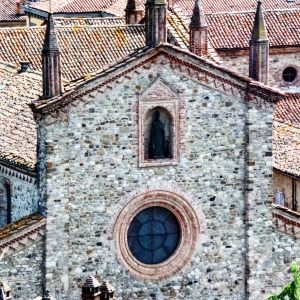
Bobbio Abbey of Saint Columbanus
Bobbio
Where:
Contacts
Located in the picturesque town of Bobbio, Bobbio Abbey was one of the major centres of learning and culture during the Middle Ages. Today, it is a top destination for those who want to learn more about the roots and history of European culture.
For centuries, Bobbio Abbey (located in the heart of Bobbio, one of the most beautiful villages in Italy) was one of the most important cultural centres of medieval northern Italy. According to legend, the Abbey was founded in 614 by Saint Columbanus, an Irish monk whose books became the nucleus of what would then become the globally renowned Abbey's library. Here, Saint Colombanus also founded his religious order, which followed a very strict code of rules.
According to the Rule of Saint Columbanus, the monks were to live a life of study and prayer as they worked tirelessly to transcribe ancient texts by hand; no wonder that the Abbey flourished and became a renowned centre of learning throughout Europe. Even between the 7th and the 10th centuries, one of the most turbulent times in the history of northern Italy (which saw the clash of Roman and Lombard culture), the Abbey and the monastic community kept growing in importance. In the last decades of the 9th century, the Rule of St Columbanus was eventually superseded by the milder Rule of St Benedict and the monastery complex was moved downstream.
In these centuries, in addition to boasting a productive Scriptorium and a remarkably large collection of manuscripts, Bobbio Abbey became a centre of resistance to Arianism and a base for the conversion of the Lombard people. Over time, the cultural and political importance of the Abbey grew, and so did the Library and the whole abbey complex, so much so that in 1153, Frederick Barbarossa made various grants of land all over Europe to the monks of Bobbio.
The monastery was suppressed in 1803 by the French, but its Library preserved many of the ancient manuscripts contained therein. At the end of the 10th century, it boasted a collection of around 700 volumes.
As the monastery declined in importance, many of its books were lost or dispersed (many of them ending up in valuable collections scattered throughout Europe and the world). That being said, the ancient Library still boasts many volumes (even though most of them are kept in the Ambrosian Library, the Turin National University Library, and the Vatican Library), including 25 of the 150 most important manuscripts of Latin culture in the world.
The wonderful Renaissance-style Basilica, the main cloister, the Town Museum, and the Abbey Museum, which is housed in the ancient Scriptorium, are also open to visitors.


